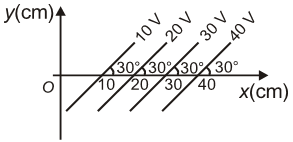The figure shows some of the equipotential surfaces. Magnitude and direction of the electric field is given by


1. 200 V/m, making an angle with the x-axis
2. 100 V/m, pointing towards the negative x-axis
3. 200 V/m, making an angle with the x-axis
4. 100 V/m, making an angle with the x-axis


An air capacitor of capacity is connected to a constant voltage battery of 12 V. Now the space between the plates is filled with a liquid of dielectric constant 5. The charge that flows now from battery to the capacitor is
1. 120
2. 699
3. 480
4. 24
Two identical metal plates are given charges respectively. If they are now brought close to form a parallel plate capacitor with capacitance , the potential difference between them is :
1.
2.
3.
4.
A and B are two concentric metallic shells. If A is positively charged and B is earthed, then electric

1. Field at common centre is non-zero
2. Field outside B is nonzero
3. Potential outside B is positive
4. Potential at common centre is positive
A 4 capacitor is charged by a 200 V supply. It is then disconnected from the supply and is connected to another uncharged 2 capacitor. How much electrostatic energy of the first capacitor is lost in the form of heat and electromagnetic radiation?
1.
2.
3.
4.
In the circuit shown in figure, energy stored in \(6~\mu\text{F}\) capacitor will be:

| 1. | \(48 \times10^{-6}~\text{J}\) | 2. | \(32 \times10^{-6}~\text{J}\) |
| 3. | \(96 \times10^{-6}~\text{J}\) | 4. | \(24 \times10^{-6}~\text{J}\) |
Four equal charges Q are placed at the four corners of a square of each side is ‘a’. Work done in removing a charge – Q from its centre to infinity is
(1) 0
(2)
(3)
(4)
Two spheres of radius a and b respectively are charged and joined by a wire. The ratio of the electric field at the surface of the spheres is
(1) a/b
(2) b/a
(3) a2/b2
(4) b2/a2
An electron of mass m and charge e is accelerated from rest through a potential difference V in vacuum. The final speed of the electron will be
(1)
(2)
(3)
(4)






